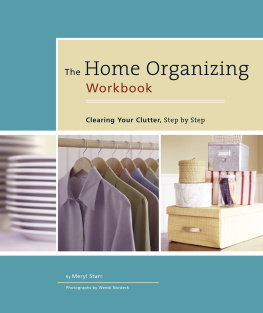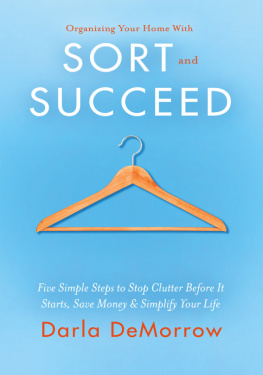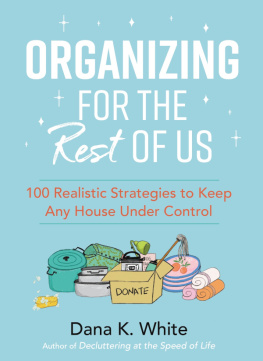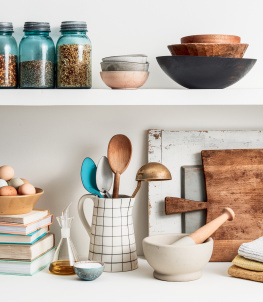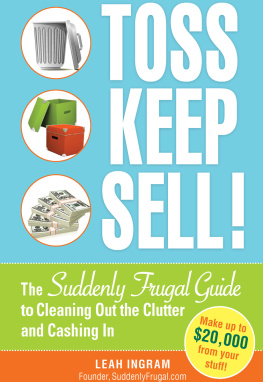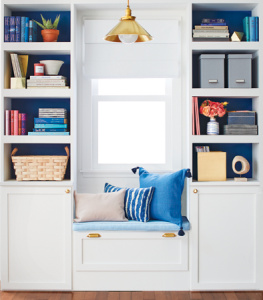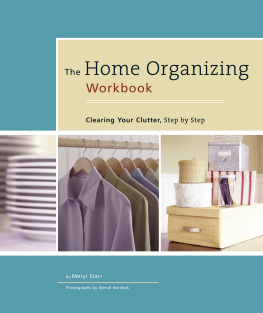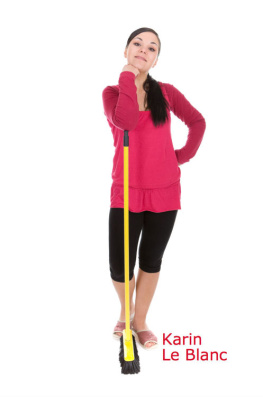



Home organization is the great equalizer. A scrupulously clean person can have a spick-and-span but poorly organized home in which clearing off the dining room table becomes an all-day task, and much-needed items seem like buried treasure without the proverbial map. On the other hand, those on the sloppy side can maintain an impressively well-organized home, in which everything sits in its logical place, and each room is simple to clean and to keep clean. Whether you count yourself the former, the latter, or (most likely) somewhere in between. The Home Organizing Workbook can help you improve existing home-organizing systems and create new ones that will work for the long term. What ultimately determines good home organization is a system that works for youa system that makes it easy for you to clear the clutter, streamline your busy life, and make your home a restful and nurturing place.
Home disorganization comes in many forms. An approach to organization that works for someone you know doesnt mean it will necessarily work for you and your family. An ill-fitting system can prevent you from accomplishing household tasks and your family from enjoying daily activities. At worst, it will promote, rather than remedy, the accumulation of clutter. Because your home-organizing problems are different from your neighbors, youll need to consider a variety of potential solutions.
The Home Organizing Workbook will help you assess your homes needs and find effective ways to meet them.
- Are you unable to relax in your living areas because youre surrounded and distracted by piles of possessions?
- Do you suspect your closets and storage areas are filled with items that you dont even know you own?
- Do you keep things because you might need them later, then find you rarely look at them againuntil you do look at them and declare you might need them later?
- Do you delay tidying up cluttered areas because you fear the task will turn into a long, involved project?
- Do you think that organizing your home is the same as cleaning it?
If you answered yes to any of these questions, this book can help you by offering simple, step-by-step strategies for clearing the clutter.
No doubt about ittrying to change your habits can be overwhelming. To control the clutter in your home, however, you dont need to achieve and maintain a state of orderly perfection. Instead, you can begin in one room, or even an area of a room, and solve one problem at a time, one step at a time. In the processwith this workbook as your guideyou will develop systems that function best for your home and help ensure long-term success.
The Home Organizing Workbook walks you through each key room in your home, starting with the kitchen and ending with such storage areas as garages, basements, and attics. A simple questionnaire at the beginning of each chapter directs you to the hot spots that need attention. Once youve defined these problem areas, you can turn to the corresponding solutions. Each chapter also has step-by-step projects that help you jump-start the process of clearing the clutter. At the end is a list of indispensable organizing tools and accessories. An extensive resource guide at the back of the book puts these tools at your fingertips.
Now that you have The Home Organizing Workbook in hand, jettison any pressures to achieve organizational perfection. Turn to a chapter, go into a room, and explore the practical advice and handy solutions. Its time to get organized.

Chapter 1
The Kitchen

If your life is like most peoples, the kitchen is probably the busiest room in your home.
Not only do you prepare and cook meals there, but you may also rely on the kitchen as a part-time office for opening mail and paying bills, maybe even for helping your kids with their homework. The kitchen is also the natural gathering place for entertaining guests. You dont want to straighten up every time you serve a meal or be in a panic before company arrives. Theres no reason to give up any of your diverse uses of the kitchen. Reorganizing will help you make the room less cluttered and more functional.
The first step is to assess how you are currently using storage space, counter-tops, and other parts of your kitchen. Answer to evaluate the problems you may need to solve. But if you have an itch to get started and dont want to tackle a major reorganization, you can begin with one of three simple projects that will make a big difference in your kitchen.

1: Are your cabinets so overstuffed that you dont know what you ownthat maybe you do have a complete set of matching wineglasses or pasta bowls but cant always find them?
2: Do you store appliances, pots, utensils, or items like cookbooks on the countertop or other surfaces because your cabinets are chock-full?
If you answered yes to either question, you probably lack sufficient cabinet space, a common problem in small homes and apartments. for tips on maximizing limited cabinet storage.
3 : Do you need to look through a number of cabinets before you find the right lid for a pan, the saucers that match your favorite cups, or an appliance you regularly use?
4 : After a shopping trip or when cleaning up after cooking a meal, do you put items in the nearest available cabinet rather than in a consistently designated place?
Answering yes to either question may indicate that regardless of having adequate space, your cabinets may be in disarray. For advice on establishing good cabinet organization, go to .
5 : Although you want to put all your mixing spoons or all your cloth napkins and placemats in one place, or want to store other kitchen essentials out of sight, are you unable to find a drawer that will hold them?
6 : Do your drawers contain stationery and hardware supplies or other items that you do not use for meal preparation, while your countertop is littered with kitchen utensils?
If you nodded yes to either of these questions, you probably lack adequate drawer space. For advice on maximizing limited drawer space or finding alternate storage solutions, turn to .
7 : Are your drawers so cluttered that you cant find the spatula you prefer to use, or the extra filters for your coffeemaker, or other kitchen tools you need daily?
8: Are related items stored in separate drawersaluminum foil in one drawer and plastic wrap in another, mixing spoons in one drawer and metal whisks in another?

